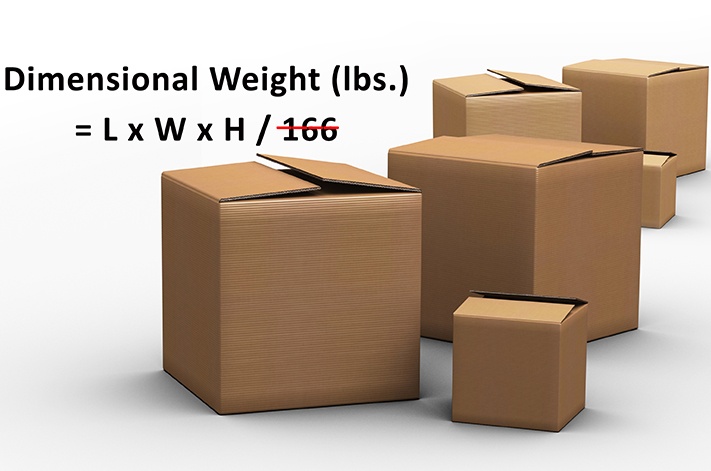
Effective Jan. 2, 2017, FedEx will change the formula used to calculate rates on domestic air or ground parcels based on their dimensions, rather than their actual weight. Currently, FedEx determines a package's dimensions by multiplying its length, width, and height in inches and dividing the sum by 166. On Jan. 2, the divisor resets to 139. Clearly, a lower divisor produces a higher net number, in this case, by about 15%. Accessorial charges such as fuel surcharge will be computed using this larger weight calculation as well.
UPS, whose daily package volumes are much larger than FedEx's, did not announce a change to its dimensional pricing formula when it disclosed its 2017 rate adjustments on Sept. 1. Currently, this pricing is applicable to domestic ground or air parcels less than 3 cubic feet. The move came about largely due to increasing volumes of ecommerce packages.
Amazon, as well as other online fulfillment companies carry a finite number of package sizes causing a significant number of packages in oversized boxes taking up more room in the plane or truck than the package weight would require. There has been talk of dimensional pricing in the freight industry for some time now.
Dimensional Pricing is Coming to the LTL Sector
According to the CEOs of some of the largest LTL trucking companies at the 2016 NASSTRAC Shippers Conference, the debate over dimensional-weight pricing has shifted from if, to when it will be applied to less-than-truckload freight. Historically, carriers’ weights and inspections programs were designed to ensure accurate weight and classification of any particular shipment. The process can be time consuming and reclassifications usually end up a contentious issue with shippers.
FedEx Freight, XPO Logistics, YRC Freight and other LTL carriers have been installing equipment that can scan a palletized shipment and, combined with scales, provide the cubic dimensions and weight needed to check the shipment classification. The general consensus among LTL industry executives is that the current classification system is on its way out. The reality is that LTL carriers sell space in a trailer. Using the dimensions of a particular pallet identifies precisely how much space that shipment will require, thereby providing accurate pricing.
Shippers Prepare
Many shippers believe dimensional pricing amounts to a rate increase, and the number of shipments, they say, are rebilled once they go through a dimensioner, supporting their contention. Shippers who are not prepared to invest in equipment to measure their shipments’ dimensional weight will have to adopt strict packaging protocols to package their freight in a uniform method as to avoid a dimensional pricing situation.
The ability to double stack pallets is a prime example. Under dimensional pricing a pallet that cannot be double stacked will be billed at 2 pallet spaces since the pallet will essentially occupy the air above it. The NMFC classification system does account for the space a particular shipment would occupy but deep tariff discounts, FAK's and the spot rate market all provide ways of getting around those classifications. To date, much of the use of dimensional pricing has been limited to W & I procedures at truck terminals. However, by capturing more and more dimensional shipment data, LTL carriers are laying the data foundation needed for the expanded use of dimensional pricing.
For more information on this or any Transportation topic, please contact Land Link Traffic Systems or call 732.899.4242.



 Land-Link, a well respected professional organization, has been providing its clients with effective transportation and logistics solutions since 1978.
Land-Link, a well respected professional organization, has been providing its clients with effective transportation and logistics solutions since 1978.

